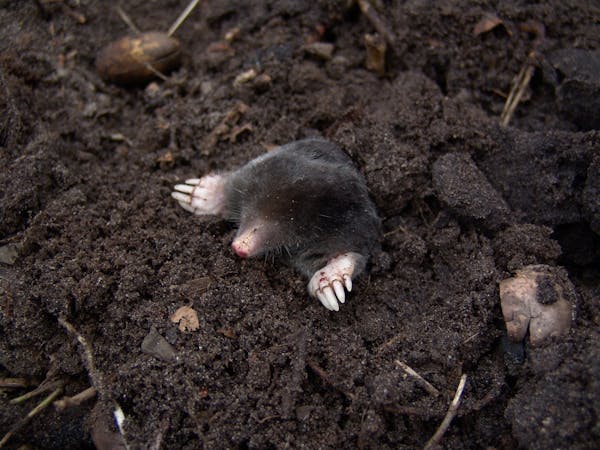Mole Removal

Mole Control: Identification, Damage, and Effective Removal
Moles can cause extensive damage to lawns, gardens, and farmland through their tunneling behavior. Understanding their activity and using the right control methods is key to protecting your property.
Signs of Mole Activity
Mole Mounds: Small, cone-shaped piles of soil created as moles tunnel underground.
Surface Tunnels: Visible as raised ridges; check for activity by pressing gently on them and observing if they reappear.
Fresh Soil: Loose, newly dug dirt indicates recent mole movement.
Damage Caused by Moles
Turf Disruption: Tunnels and mounds make lawns uneven and difficult to maintain.
Root Disturbance: Plant roots can be damaged by tunneling, leading to stress and wilting.
Crop Impact: In agricultural settings, moles can harm crops and disrupt irrigation systems.
Indirect Pest Issues: Moles attract predators and scavengers, which may cause additional garden damage.
Mole Species Identification
Knowing the mole species (e.g., Eastern mole, Star-nosed mole) helps select the right trap type and strategy, as sizes and behaviors vary.
Control Methods
1. Trapping (Most Effective)
Place traps in active tunnels—identified by fresh soil and raised ridges.
Types of Traps:
- Scissor Traps: Good for smaller moles; effective in shallow tunnels.
- Harpoon Traps: Designed for deeper or larger tunnels.
- Box Traps: Capture live moles; used for humane removal.
- Choker Loop Traps: Loop tightens as the mole passes through.
Tip: Use gloves to avoid leaving human scent on traps. Always monitor and reposition traps as needed.
2. Repellents & Barriers
Natural Repellents: Castor oil-based solutions.
Mole-Repellent Plants: Garlic, marigolds, and daffodils.
Physical Barriers: Underground wire mesh around sensitive areas.
3. Other Control Options
Vibration Devices: Solar-powered deterrents placed in the soil.
Soil Treatments: Nematodes target grubs (mole food source), reducing activity.
Note: Poisoned baits are available but are discouraged due to environmental and safety risks for pets and non-target species.
Trap Placement Tips
Focus on active tunnels, not just mounds.
Traps should be aligned along the tunnel path, with minimal soil disturbance.
Moles are most active early morning and late afternoon, especially in moist soil conditions.
Health & Safety Considerations
Though rare, moles can carry fleas, mites, or host ticks that transmit Lyme disease. Handle all traps with gloves, and dispose of captured animals responsibly.
The most effective mole control strategy is accurate tunnel identification combined with proper trap placement. For long-term management, combine trapping with soil care, repellents, and environmental adjustments.
Mole Deterrents and Prevention Strategies
Below are the most practical and humane mole deterrent methods for a wildlife-conscious approach.
Why Not Encourage Mole Feeding Activity?
While moles do contribute to soil aeration and pest control, setting up intentional feeding zones can cause more harm than good.
Reasons to Avoid Creating Feeding Runs:
- Lawn and Garden Damage: Their tunneling can uproot plants and destroy landscaping.
- Worsened Infestations: Attracting more moles often leads to widespread tunneling.
- Ecosystem Disruption: Overpopulation can disturb soil health and encourage erosion.
- Increased Predators: Mole tunnels may invite raccoons, skunks, or other predators.
- Harder to Control: Moles are adaptable; once they settle in, removal becomes more difficult.
Effective Mole Deterrents
1. Natural Repellents
Castor Oil: Mix with water and a few drops of dish soap, then spray on soil.
Essential Oils: Peppermint, eucalyptus, and citronella on cotton balls or diluted in water.
Garlic & Hot Pepper Sprays: Crushed and mixed with water to spray near tunnels.
Coffee Grounds: Spread in garden beds to irritate moles and deter digging.
2. Commercial Products
Granular Repellents: Often made with castor oil, garlic, or capsaicin.
Bittering Agents: Soil treatments that make the area less appealing.
Predator Urine: Fox or coyote scent-marking products can create the illusion of threat.
3. Scent-Based Strategies
Human Urine: Can be poured near tunnels or borders (reapply regularly).
Synthetic Predator Scents: Available online or in garden centers.
Sound & Vibration Deterrents
1. Ultrasonic & Sonic Emitters
Solar-Powered Models: Emit low-frequency vibrations to disturb moles underground.
Battery-Powered Units: Useful in shaded areas; should be spaced every 20–30 feet.
Installation Tips:
Insert devices 5–10 inches into the soil.
Place where mole activity is highest.
Use in a grid to cover wide areas.
Habitat Modification
1. Soil & Moisture Management
Avoid overwatering to limit mole-friendly environments.
Aerate soil regularly to improve drainage and decrease earthworm populations (a mole food source).
2. Use of Mole-Repellent Plants
Daffodils, Marigolds, Garlic, Lavender, and Rosemary may discourage mole presence with their strong scents.
3. Physical Barriers
Underground Mesh: Install wire mesh 1/2 inch wide, buried at least 2 feet deep.
Raised Beds: Line with mesh to prevent mole intrusion.
Identifying Mole Entry Points
Fresh Tunnels & Molehills: Soft, raised earth indicates active paths.
Edges of Lawns: Moles often enter via fences, flower beds, or structures.
Water-Adjacent Areas: Moles thrive in moist, insect-rich soils.
Check for active tunnels by flattening them and seeing if they reappear the next day. This is where deterrents or traps will be most effective.
Combining Deterrents for Best Results
While some moles may adapt over time, combining methods—such as scent, sound, soil management, and barriers—provides a comprehensive deterrent plan. Regular monitoring and quick response to signs of activity can prevent small issues from becoming infestations.